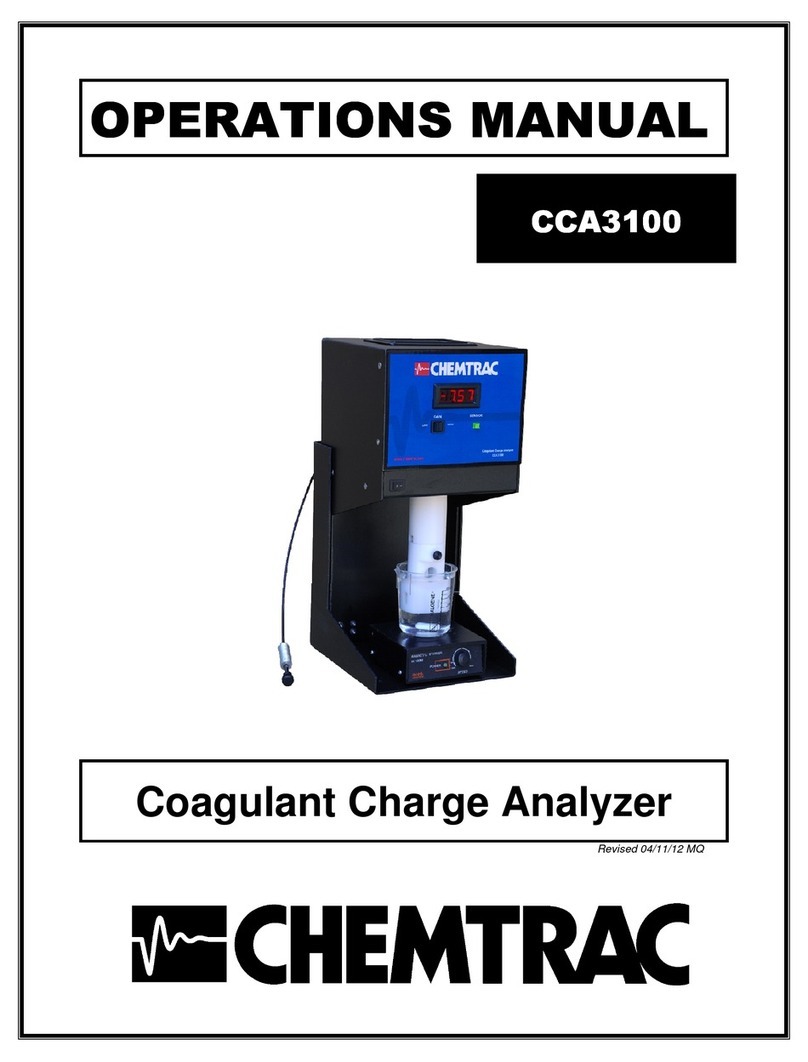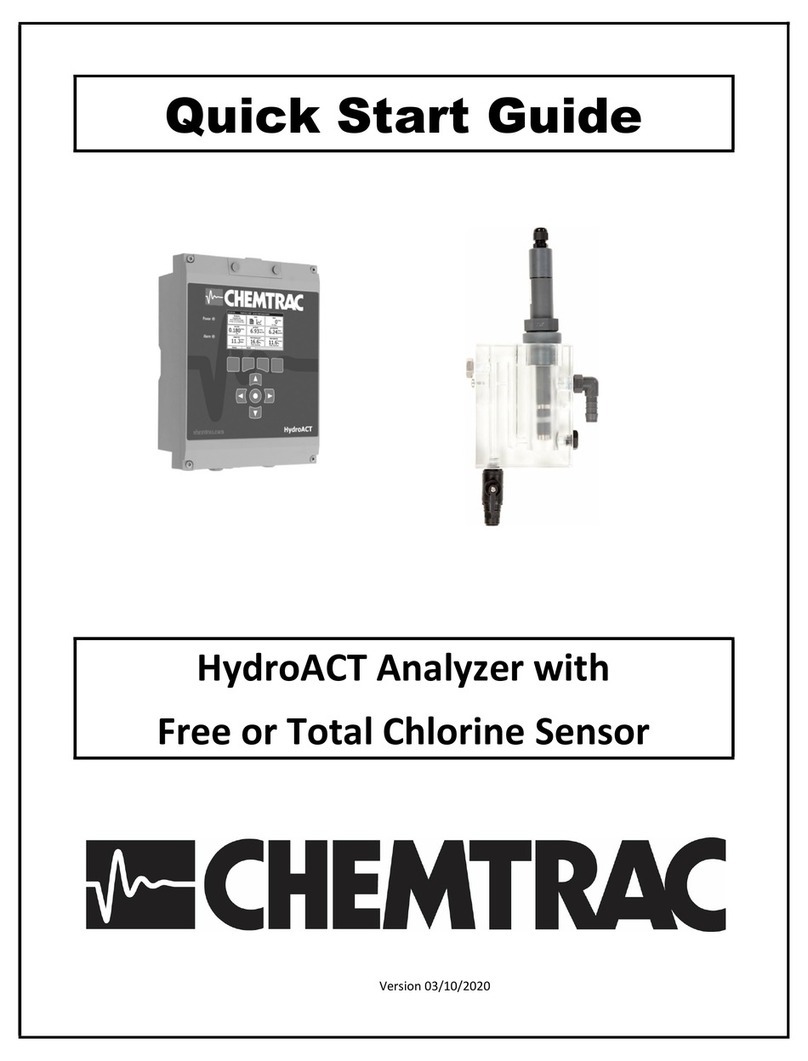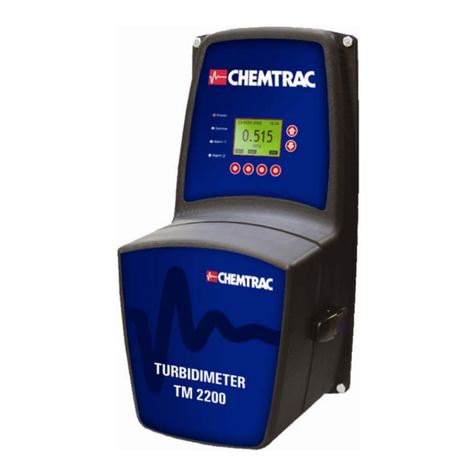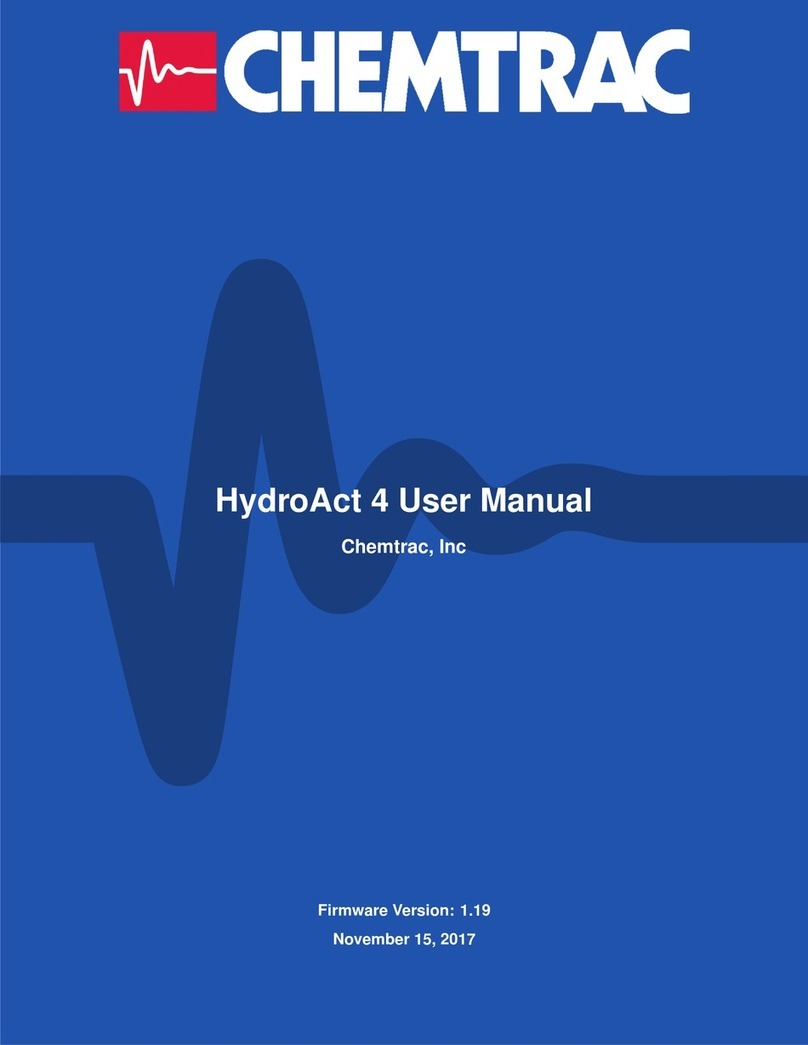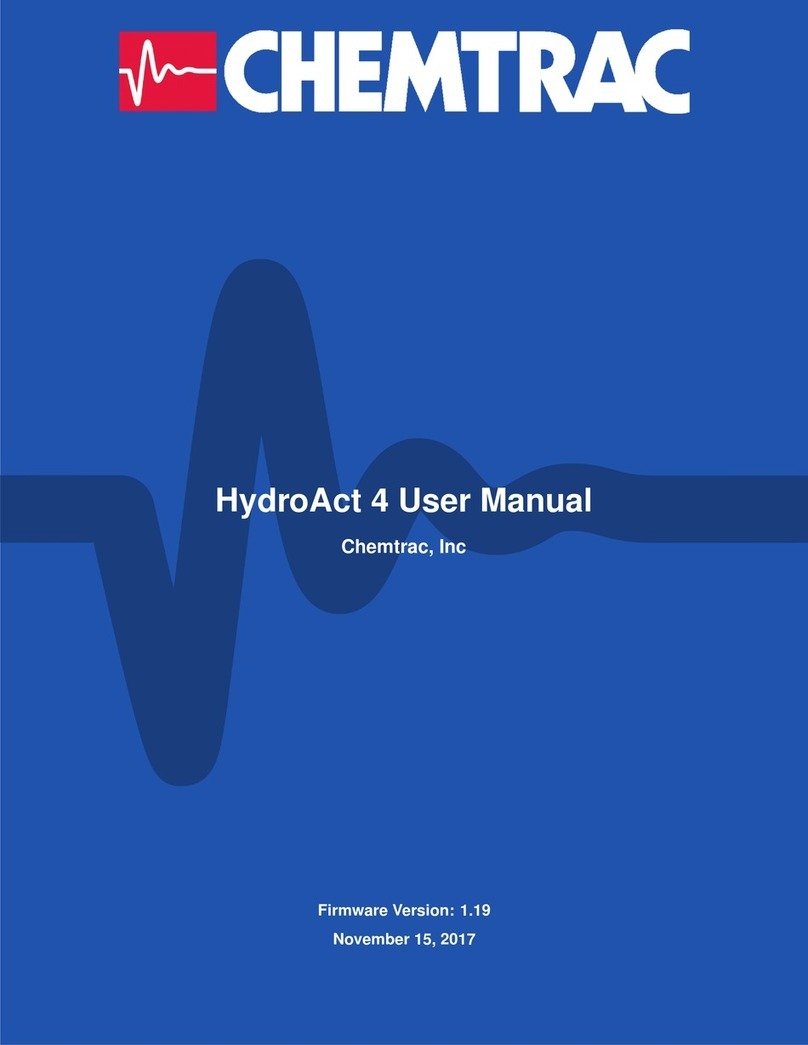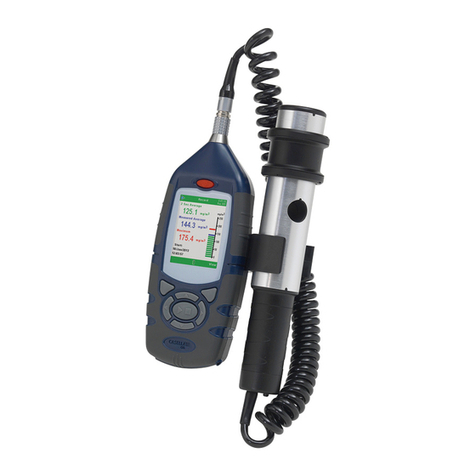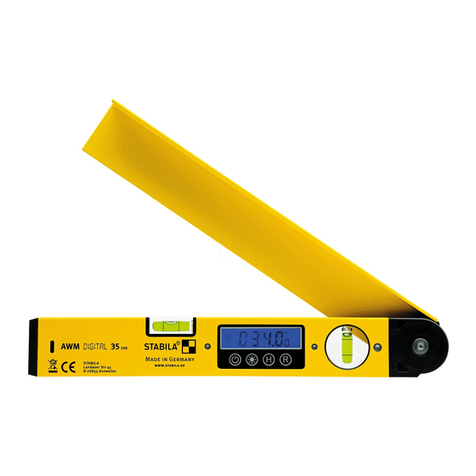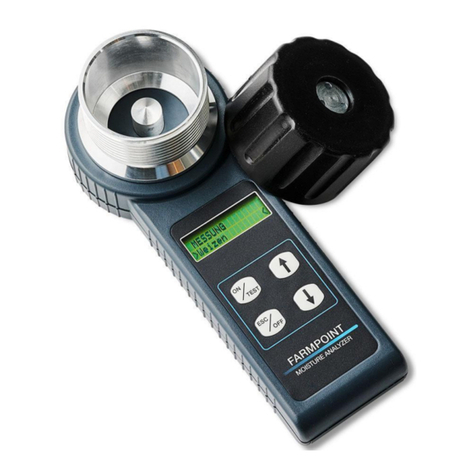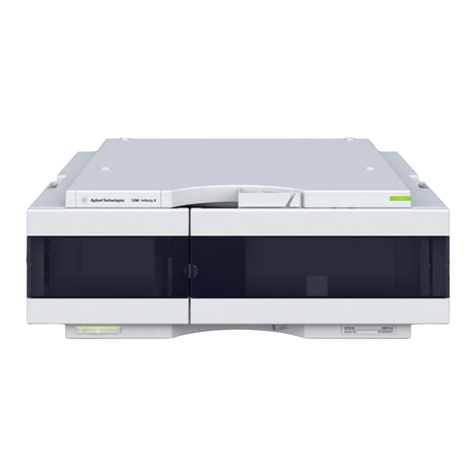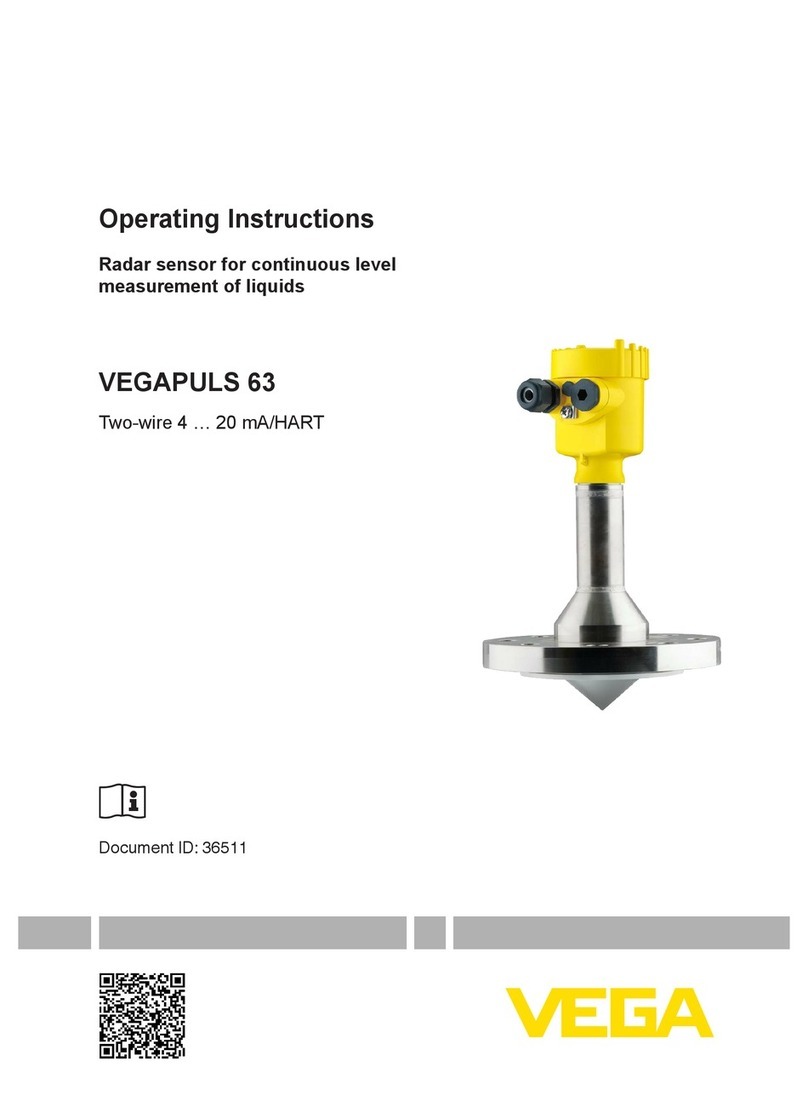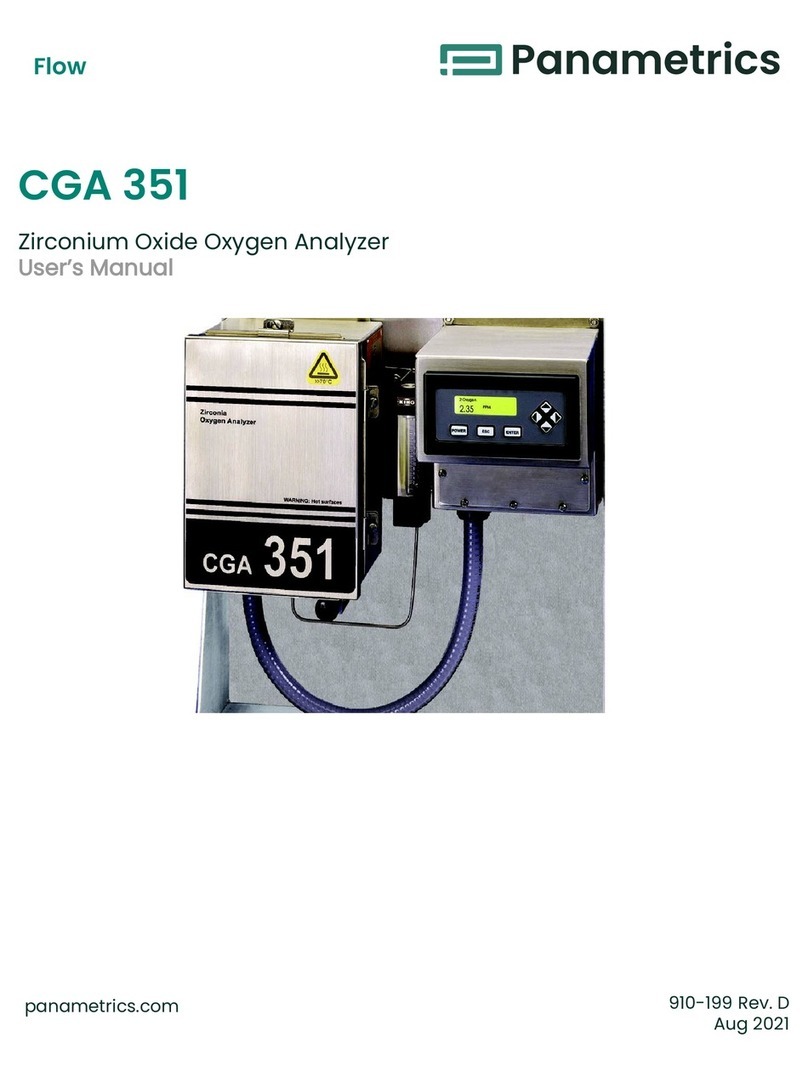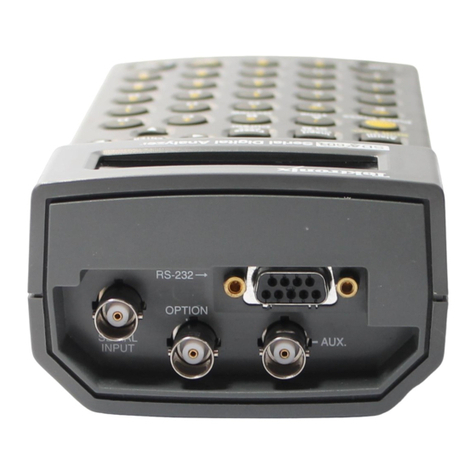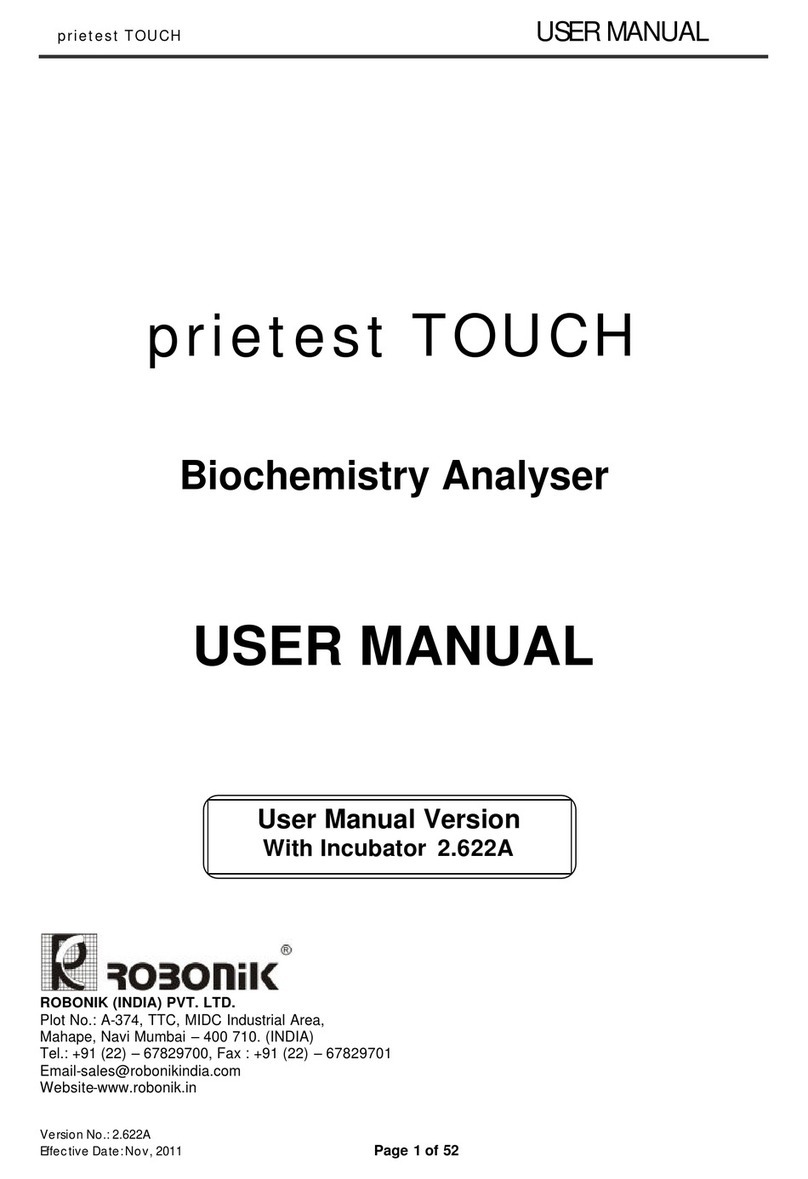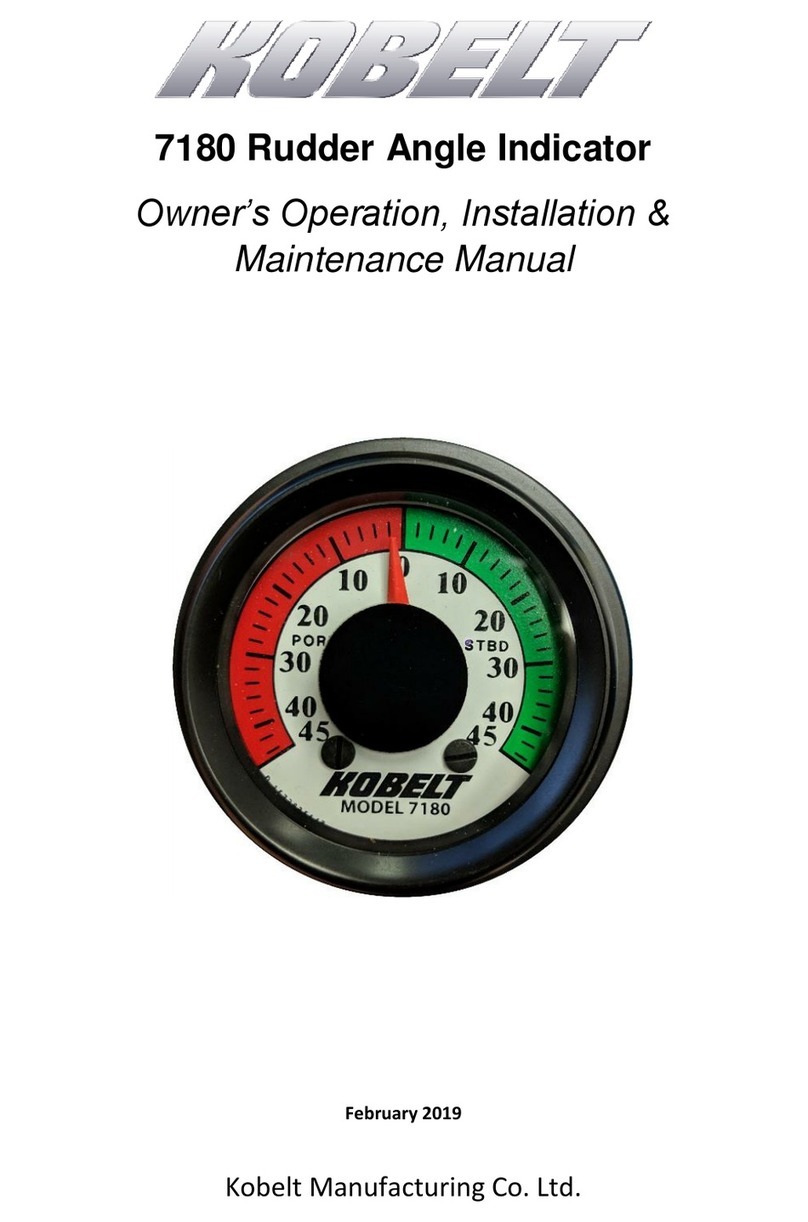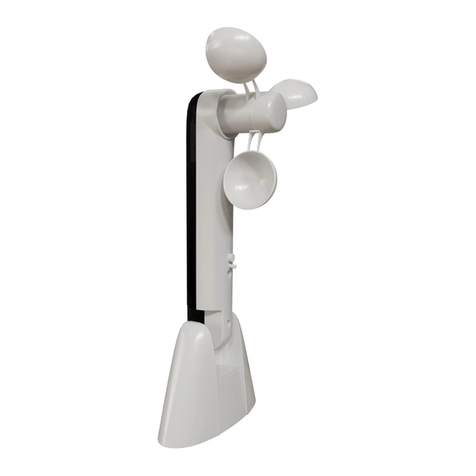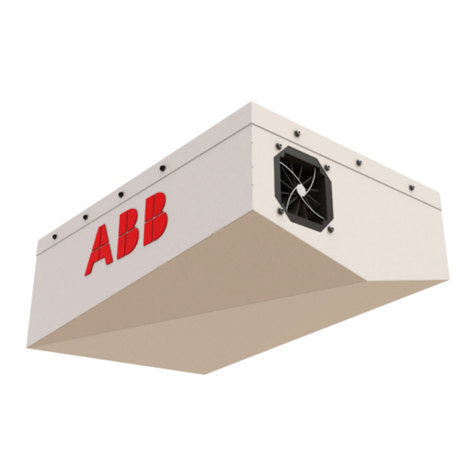Chemtrac LCA-1 User manual

OPERATIONS MANUAL
Laboratory Charge Analyzer
Revised 05/01/2017
Models: LCA-1, LCA-2, LCA-3

2

3
TABLE OF CONTENTS
Contents
1. Product Description..............................................................................................................................5
1.1 General..........................................................................................................................................5
1.2 Applications...................................................................................................................................6
1.2.1 Determining Coagulant Dosage............................................................................................6
1.2.2 Determining Caustic Dosage ................................................................................................6
1.2.3 Determining Polymer Dosage ...............................................................................................6
1.2.4 Charge Demand....................................................................................................................6
1.2.5 Determination of Isoelectric Point .........................................................................................6
1.2.6 Other Applications.................................................................................................................6
1.3 Model Designation ........................................................................................................................6
1.4 Included Items...............................................................................................................................6
1.5 Options..........................................................................................................................................6
1.5.1 pH and Temperature.............................................................................................................6
1.5.2 Roll Away Case.....................................................................................................................6
1.6 Specifications................................................................................................................................7
1.7 LCA Components..........................................................................................................................8
1.7.1 LCD Display & Menu Keypad................................................................................................8
1.7.2 Stand Release (Raise & Lowers Stand) ...............................................................................9
1.7.3 Probe and Piston...................................................................................................................9
1.7.4 Beaker (Optional)..................................................................................................................9
1.7.5 Magnetic Stirrer and Stir Bar.................................................................................................9
1.7.6 Coagulant / Polymer Titrant Container..................................................................................9
1.7.7 Acid / Base Titrant Container ................................................................................................9
1.7.8 Coagulant / Polymer Titrant Pump........................................................................................9
1.7.9 Acid / Base Titrant Pump ......................................................................................................9
1.7.10 pH electrode and Temp probe ..............................................................................................9
2. User Menu..........................................................................................................................................10
2.1 Titration Setup (LCA-2 & LCA-3 Only)........................................................................................10
2.1.1 Sample Volume...................................................................................................................10
2.1.2 Charge Titration...................................................................................................................10
2.1.3 pH Titration (LCA-3 Only)....................................................................................................11
2.2 Calibration...................................................................................................................................12
3. Operation............................................................................................................................................13
3.1 Water Treatment –Determining Optimum Coagulant Dosage...................................................13

4
3.1.1 Introduction..........................................................................................................................13
3.2 Preparation for Sample Testing ..................................................................................................17
3.2.1 Collect Raw Water Sample.................................................................................................17
3.2.2 Prepare Sample for Testing................................................................................................18
3.2.3 Positioning Sensor into Sample..........................................................................................18
3.2.4 Sensor Conditioning & Stabilization....................................................................................19
3.2.5 pH Measurement and Adjustment.......................................................................................19
3.2.6 Titration Procedure..............................................................................................................20
4. Maintenance.......................................................................................................................................22
4.1 Signal Health Readout ................................................................................................................22
4.2 LCA Sensor Cleaning..................................................................................................................22
4.2.1 Cleaning Procedure ............................................................................................................22
4.2.2 Use of Approved Cleaners..................................................................................................23
4.2.3 List of Approved Cleaners For LCA Sensor........................................................................23
4.3 Titrant Pump Cleaning / Maintenance.........................................................................................24
4.4 pH Probe Cleaning......................................................................................................................24
4.5 Storage........................................................................................................................................25
4.5.1 LCA Storage........................................................................................................................25
4.5.2 pH Probe Storage................................................................................................................25
4.6 LCA Sensor Check and Calibration ............................................................................................25
4.6.1 Basic Function Test.............................................................................................................25
4.6.2 Test Procedure Using Verification Solutions......................................................................25
4.7 Application Questionnaire...........................................................................................................27
Figure 1 - Double Layer Charge ...................................................................................................................5
Figure 2 - Streaming Current Sensor............................................................................................................5
Figure 3 –LCA Components ........................................................................................................................8
Figure 4 –Display & Menu Keypad ..............................................................................................................8
Figure 5 –User Menu Diagram...................................................................................................................10
Figure 6 –Optimum Depth of Probe in Sample..........................................................................................19
Figure 7 –Manual Titration.........................................................................................................................20
Figure 8 –Automatic Titration.....................................................................................................................21

5
1. Product Description
1.1 General
The Laboratory Charge Analyzer (LCA) is used to
determine the charge demand (aka coagulant
demand) of an aqueous sample like raw water
coming into a water treatment plant. The LCA
performs a titration of the sample using
coagulants (or polymers) until the sample’s
charge is neutralized. The LCA provides a real-
time measurement of charge neutralization using
streaming current technology. Streaming current
is a term which is commonly interchanged with
“charge” or “charge measurement.” Streaming
current is a very small current that is generated
by the mechanical separation, or shearing, of ions
from the diffuse layer that surrounds charged
species like macromolecules and colloidal
particles (Figure 1).
A streaming current device (Figure 2) is easily
identified by its reciprocating plastic piston that
travels inside the annulus of a plastic probe fitted
with two electrodes. The movement of the piston
displaces the liquid in the annulus, forcing the
liquid to travel rapidly across the piston surfaces.
Soluble and colloidal charged species in the
sample momentarily attached to the reciprocating
piston via Van Der Waals attraction forces, and
the rapid fluid motion across the piston surface,
causes loosely bound counter-ions to be sheared
away from the charged species attached to the
cylinder walls. Electrodes in the cylinder
measure this tiny current generated by the
sheared counter-ions. The signal is electronically
processed and the resulting readout is called the
streaming current value (SCV), which can be
thought of as a mV value, but actual correlation
to a true mV value is not possible unless the
instrument is specially calibrated using zeta
potential measurement.
The SCV is sometimes referred to as “Particle
Charge” or “Ionic Charge” measurement by other
manufacturers.
The LCA-3 is unique among lab charge analyzers
in that it can control the pH during the charge
titration and this allows the LCA to more
accurately determine the optimum coagulant
dosage (versus those units which cannot control
pH). Sample pH is especially important when
working with inorganic coagulants and pH must
be taken into consideration when performing
titrations in order to obtain accurate charge
demand analysis results.
Higher alkalinity samples may require the pH to
first be lowered with additions of Acetic in order
to ensure the aluminum species are in the correct
form for charge analysis (this is akin to chlorine
measurements where the sample pH is buffered
to improve measurement accuracy). Lower
alkalinity samples will possibly require the
addition of a base (e.g.. sodium hydroxide). This
manual attempts to cover the most important
aspects of the laboratory charge analysis testing
procedures, but it is very important to realize that
several factors will impact the measurement
result. It is highly recommend to consult with
Chemtrac’s application experts to ensure the test
procedure is optimized for plant conditions.
Figure 1 - Double Layer Charge
Figure 2 - Streaming Current Sensor

6
1.2 Applications
1.2.1 Determining Coagulant Dosage
In water treatment applications, the LCA provides
a fast and simple method of determining the
optimum coagulant or polymer dosage needed
for maximum removal of turbidity (NTU) and
organics (NOM/TOC).
1.2.2 Determining Caustic Dosage
The LCA-3 with its automatic pH titration can be
used to determine how much base (e.g. caustic,
lime) is needed along with coagulant to achieve
optimum pH conditions for coagulation.
1.2.3 Determining Polymer Dosage
In wastewater applications, the LCA can
potentially be used to help optimize polymer
dosage for clarification and dewatering.
Measurements of centrifuge centrate, or gravity
belt thickener or belt filter press filtrate, can be
made to see where charge is running, and
confirm proper dosing.
1.2.4 Charge Demand
In Pulp & Paper applications, the LCA is used to
determine the cationic or anionic charge demand
of a sample which helps quantify swings in
charge that can occur on the paper machine.
Charge demand is determined by titrating a
sample with a polymer of opposite charge
(typically DADMAC or PVSK).
1.2.5 Determination of Isoelectric Point
The LCA can be used to find the Isoelectric Point
(IEP) of dispersions using an Acid or Base
titration. The IEP is the pH at which a particular
molecule or particle carries no net electrical
charge.
If the sample is cationic, the sample is titrated
with a base until the SCV value reaches 0 (or
neutral). If the sample is anionic, an acid is used
instead.
1.2.6 Other Applications
The LCA can be used in a variety of other
applications where soluble/colloidal charge is of
concern.
1.3 Model Designation
The LCA comes in three models which are
identified as LCA-1, LCA-2, and LCA-3. The
model number is located on the instruments
identification label, which is found on the back of
the device.
LCA-1 has no internal titration pumps, requiring
all titrations to be performed manually.
LCA-2 has one internal pump for titrating the
sample with a coagulant or polymer.
LCA-3 has two internal titration pumps. One
pump is for titrating the sample with a coagulant
or polymer. The second pump can be used for
titrating the sample with an acid or base; or used
with an anionic polymer when doing charge
demand titrations. The LCA-3 comes standard
with the pH and temperature probe option.
1.4 Included Items
LCA Model:
1
2
3
Probe
Piston
Magnetic Stirrer
Stir Bar
Sample Beaker
Opt
Opt
Opt
Power Cord
pH Probe
Opt
Opt
Coag / Poly Dosing Pump
Acid / Base Dosing Pump
5 cc Graduated Cylinder
1.5 Options
1.5.1 pH and Temperature
Models LCA-1 and LCA-2 can be equipped with
the pH and temperature probe option. This option
comes standard on model LCA-3. The pH probe
allows the user to easily perform pH adjustment
prior to or during the coagulant titration. This
option also allows the user to easily conduct
testing for determining the isoelectric point.
1.5.2 Roll Away Case
The roll away case allows for easier transport and
safe storage of the LCA.

7
1.6 Specifications
Dimensions Width: 8.5”
Depth: 9.2”
Height (Stand Lowered): 26”
Height (Stand Raised):
Weight 18 lbs. (8.2 kg)
Power Requirements 115VAC, 50/60Hz, 410 mA
Optional 220VAC, 50/60Hz, 205 mA
Environmental Temperature 41-140F / 5-60C
Enclosure Powder Coated Aluminum
Display Backlit LCD
Measurements LCA-1
-SCV (Streaming Current Value, or mV)
-Manual/Hand Titration
LCA-2:
-SCV (Streaming Current Value, or mV)
-Automatic Charge Titration
-Coagulant Dose (ppm, mg/l)
-Charge Demand (μeq/l)
LCA-3:
-SCV (Streaming Current Value, or mV)
-Automatic Charge Titration
-Coagulant Dose: parts per million (ppm)
-Charge Demand: μeq/l
-Automatic pH Titration
-pH & Temp (F/C)*
-Acid/Base Dose: parts per million (ppm)*
-pH of isoelectric point (optional, requires pH)*
*Also available as option on LCA-1 and LCA-2
Sample Size 225 mL to 2000 mL (250 mL, 1000 ml, or 2000 ml beaker
sizes can be used, Beakers not included)
Materials in contact with sample Delrin, 316 stainless steel, PTFE (magnetic stir bar)
Titrant Pumps (LCA-2 and -3 only) Solenoid operated micro-pump with 50 µl dispense
volume. Material of construction: POM, PTFE, FKM.
LCA-2 has single pump, LCA-3 has two pumps.
Titrant Bottles (LCA-2 and -3 only) 250 mL Nalgene Bottles
pH Probe (Optional, Standard on LCA-3) Measurement range 0 –14.
Temp Probe (Optional, Standard on LCA-3) Measurement range 0 –140 F

8
1.7 LCA Components
Figure 3 –LCA Components
1. LCD display
2. Keypad (Menu, navigation buttons,
Motor Power, Titrate, & Prime)
3. Stand Release (raises & lowers stand)
4. Probe & piston
5. Beaker (optional, sizes may vary)
6. Magnetic stirrer with stir bar
7. Titrant container (coagulant, cationic
Polymer) LCA-2 & LCA-3 Only
8. Titrant container (acid, base, anionic
polymer) LCA-3 Only
9. Coagulant/polymer pump (LCA-2, -3)
10. Acid or base pump (LCA-3)
11. pH probe (optional, standard on LCA-3)
Temp probe (opt., standard on LCA-3)
1.7.1 LCD Display & Menu Keypad
Figure 4 –Display & Menu Keypad
1. Streaming current value (charge). Range
-1000 to +1000
2. pH reading. Range 0 to 14
3. Elapsed time. Shows how long the
titration has been running
4. Signal Health. Reads >90% when probe
signal is healthy. <90% could mean
sensor needs maintenance, or possibly
too much solids in the sample.
5. Primary dosing pump dosage. Shown
here as coagulant dosage. Will display
as ml, ppm, or µeq/l.
6. Secondary dosing pump dosage. Shown
here as base dosage. Will display as ml,
ppm, or µeq/l.
7. Menu button. Allows user to calibrate
readings and change titrator settings
8. Enter button, and Motor On / Off button.
Serves as “enter” button when in menu,
and stops and starts the motor when in
normal operation.
9. Menu navigation buttons
10. Titrate button. Starts the titration.
11. Prime button. Causes pump to dispense
50 strokes to prime and verify pump
calibration.

9
1.7.2 Stand Release (Raise & Lowers Stand)
The Stand Release button on the left hand side
of the enclosure is used to raise and lower the
LCA so that a sample beaker can be placed
under the sensor.
1.7.3 Probe and Piston
The probe and piston are both made of durable
Delrin plastic. These are critical components of
the LCA which produce the streaming current
reading. Proper care and inspection of these
parts is important to maintaining accurate charge
measurement results. Refer to maintenance
instructions in this manual for proper cleaning and
care of these parts.
1.7.4 Beaker (Optional)
Beakers are not supplied with the LCA but can be
ordered with the unit if desired. Various size
beakers can be used with the LCA. The smallest
beaker is a 250 mL and the largest size beaker
that is typically recommended is 2,000 mL.
Round or square beakers, glass or plastic, are
fine to use.
1.7.5 Magnetic Stirrer and Stir Bar
The LCA is supplied with a magnetic stirrer and
stir bar. The adjustable height of the LCA allows
for other magnetic stirrer make & models to be
utilized if desired.
1.7.6 Coagulant / Polymer Titrant Container
Models LCA-2 and LCA-3 come equipped with a
250 mL Nalgene Titrant Container for coagulant
(e.g. Alum, Ferric) or polymer (e.g. Dadmac).
This titrant container is located on the left side.
The coagulant or polymer needs to be diluted
down into a 1% (or less) solution.
1.7.7 Acid / Base Titrant Container
The LCA-3 has an additional titrant container on
the right side that is to be filled with the
appropriate acid or base solution. The acid or
base titrant must be diluted (typically 1% or less)
and compatible (in the diluted form) with the
following materials: POM, PTFE, FKM. Acetic
acid is usually recommended when pH reduction
is required prior to charge titration (typically
required for higher alkalinity samples when using
coagulants like alum, ferric, or low basicity PACl).
A base like sodium hydroxide is recommended
when pH needs to be raised during the titration to
maintain optimum pH. The raising of the pH
during the charge titration may be required on
lower alkalinity / lower pH waters, especially
when feeding acidic coagulants (e.g. alum or
ferric).
1.7.8 Coagulant / Polymer Titrant Pump
The coagulant titrant pump (also referred to as
the charge titration pump) is located to the left of
the probe on models LCA-2 and LCA-3. Each
stroke of the pump delivers approximately 50 µl
of coagulant. This pump cannot be used to titrate
neat (undiluted) coagulants.
1.7.9 Acid / Base Titrant Pump
The acid/base pump (also referred to as the
buffer pump) is located to the right of the probe
on model LCA-3. Each stroke of the pump
delivers approximately 50 µl of buffer solution.
This pump cannot be used to titrate neat
(undiluted) buffers.
1.7.10 pH electrode and Temp probe
The pH electrode and temperature probe is
optional on models LCA-1 and LCA-2, but comes
standard on LCA-3 They are located to the right
side of the LCA’s probe. The pH probe is
connected to a BNC male connector for easy
removal. The temperature probe is permanently
affixed to the LCA and cannot be removed
(except by factory). The pH reading is very
important to obtaining accurate charge readings
and coagulant dosage determination on the LCA.
The probe should be kept wet at all times and put
into pH 7 buffer solution for short term storage.
Place probe in KCl storage solution for longer
term storage. Handle carefully to avoid dropping
and damaging the probe.

10
2. User Menu
There are 3 main sections of the user menu which
are titled:
1. Titration Setup (LCA-2 & LCA-3 only)
2. Calibration
3. Utilities
Figure 5 –User Menu Diagram
2.1 Titration Setup (LCA-2 & LCA-3 Only)
The Titration Setup menu is where settings
relating to all aspects of the titration (e.g. titration
controls, titrant data, sample volume, etc.) are to
be found.
2.1.1 Sample Volume
Sample volume can be set for 1 to 2000 ml. The
typical sample size will be 200 to 2000 ml when
working with undiluted samples. Smaller
volumes can be entered into the Sample Volume
setting when working with diluted samples (e.g.
10 mL of sample diluted into 200 ml of DI water).
2.1.2 Charge Titration
This menu contains all the settings necessary for
controlling the coagulant (or polymer) addition
rate during the charge titration, as well as other
functions discussed in sections 2.1.2.1 to 2.1.2.5.
These menu features are only available on
models LCA-2 and LCA-3.
2.1.2.1 Titration Control
The Charge Titration Control menu allows the
user to select between the following modes:
•Disabled –Turns off the charge titration
feature and allows the LCA-3 to just
perform a pH titration.
•Adaptive Fast –This is the
recommended mode to use for charge
titrations. The adaptive titration modes
automatically speed up and slow down
the rate of titration based on the rate of
change in the charge reading. Adaptive
Fast mode will complete the charge
titration generally in 3 to 6 mintues. If
charge titration finishes in under 2
minutes, there will likely be overshooting
of the neutral endpoint, in which case
Adaptive Slow mode should be used.
•Adaptive Slow –This is the
recommended mode to use for charge
titrations when Adaptive Fast proves to
titrate too quickly and overshoots the
neutral endpoint by more than 10 SCV
units.
•Fixed Rate –This mode allows the user
to customize the titration rate across 3
ranges. Using this mode, the titration
rate could be set the same across all 3
ranges for a fixed rate of titration from
start to finish, which can be useful for
developing titration curves.
After selecting either the Adaptive Fast or
Adaptive Slow modes, the next screen allows
the user to select the “Initial” dosing rate (e.g.
ppm per minute) that the pump will start off at,
and also select the Minimum and Maximum
dosing rates.
Set the “Initial” dosing rate to 50% of the typical
coagulant dosage needed to treat the sample.
Set the “Minimum” dosing rate to equal 10% of
the typical coagulant dosage needed to treat the
sample.
Set the “Maximum” dosing rate to equal 50% of
maximum coagulant dosage needed to treat the

11
sample (e.g. dosage required during rain
events).
For example, if working with a raw water sample
that typically requires a coagulant dosage of 10
ppm and sometimes the dosage needs to be as
high as 50 ppm during rain events, then the
following settings would be adequate.
Initial = 5 ppm (50% of typical 10 ppm dose)
Minimum = 1 ppm (10% of typical 10 ppm dose)
Maximum = 25 ppm (50% of max 50 ppm dose)
Using these settings, the LCA will automatically
adjust the dosing rate based on changes it
measures in the charge reading.
2.1.2.2 Titrant Data
For accurate parts per million (ppm) readout, the
user must enter the % solution strength of the
diluted coagulant solution (e.g. 1%).
.
2.1.2.3 Initial Dose
If the sample being tested is always going to
require a known minimum coagulant or polymer
dosage, then enter that minimum dosage as the
“Initial Dose.” This can help reduce the time
required to perform titrations.
2.1.2.4 Maximum Dose
Set for a value that is greater than the highest
expected maximum dosage required to treat a
sample. If the LCA is performing a titration and
reaches this “Maximum Dose,” it will stop the
titration and display an error message. This
prevents the pump from running continuously in
the event the titrant bottle runs empty.
2.1.2.5 Readout Units
The dosage readout on the LCA can be set for ml
(milliliter), ppm (parts per million), or ueq/l (micro
equivalents per liter).
2.1.3 pH Titration (LCA-3 Only)
This menu contains all the settings necessary for
controlling the acid or base addition rate during
the pH titration, as well as other functions
discussed in sections 2.1.3.1 to 2.1.3.6. These
menu features are only available on model LCA-
3.
2.1.3.1 Target pH
Set the target pH to the value needed to achieve
accurate dosage determinations for the
coagulant being utilized. If unsure what to use,
go by the below table and make adjustments from
there as needed.
Set the Deadband to 0.1 for most applications.
The Deadband setting determines how close pH
needs to be to the target pH before the titration is
allowed to finished.
Why is there a Target pH? What do I use?
The pH is very important to charge measurement
and to achieving accurate coagulant dosage
determination. This is especially true when
working with inorganic coagulants like alum or
ferric. If these coagulants are fed into a raw water
sample that is not in the ideal pH range when
performing testing with the LCA, then the dosage
determination will not be accurate. See section
3.1 (specifically 3.1.1.8 and 3.1.1.9) for more
information on why Target pH is used.
2.1.3.2 Titration Control
The pH Titration Control menu allows the user to
enable or disable the pH titration feature. It also
allows for adjusting the dosing rate of the buffer
during the titration.
Proportional Gain can be used to speed up or
slow down the dosing rate. Raising the
Proportional Gain will increase the rate at which
the acid or base is dosed into the sample. Lower
this setting slows down the dosing rate.
Adjust the Proportional Gain, and the Minimum
and Maximum dosing rate as follows:
Prop. Gain –Typically set for 0.5. Raise to a
higher value (e.g. 1.0) if the pH is dropping by
more than 0.5 pH units away from Target pH
during the charge titration, or if the pH adjustment
is taking too long to complete after charge

12
reaches its neutral reading. WARNING –Setting
the Prop. Gain setting too high can cause
overshooting of the Target pH and result in
inaccurate coagulant dosage determination. It is
better for the pH adjustment to be on the slower
side as this ensures more accurate coagulant
dosage determination.
Minimum –Typically set for 1.00. This setting can
be raised if pH adjustment is too slow to make the
last final pH adjustment as the pH nears the
Target pH.
Maximum –Typically set for 50% of whatever the
highest dosage of buffer is going to be required.
2.1.3.3 Titrant Data
The pH Titrant Data menu allows the user to
select whether an acid or base solution is being
used with the auto titration pump. For accurate
parts per million (ppm) readout, the user must
enter the % solution strength of the dilluted buffer.
2.1.3.4 Initial Dose
If the sample being tested is always going to
require a known minimum acid or base dosage,
then enter that minimum dosage as the “Initial
Dose.” This can help reduce the time required
to perform titrations.
2.1.3.5 Maximum Dose
Set for a value that is greater than the highest
expected maximum dosage required to adjust the
sample’s pH If the LCA is performing a titration
and reaches this “Maximum Dose”, it will stop the
titration and display an error message. This
prevents the pump from running continuously in
the event the titrant bottle runs empty.
2.1.3.6 Readout Units
The dosage readout on the LCA can be set for ml
(milliliter), ppm (parts per million), or ueq/l (micro
equivalents per liter).
2.2 Calibration
The calibration menu allows the user to calibrate
the Streaming Current Value (SCV). To calibrate
the SCV, submerge the sensor in raw water (with
not coagulant) and adjust the value to read -200
and press Enter.
The pH calibration can be performed using one,
two, or three buffers. Or, simply perform a single
point calibration to reference the pH reading to
another recently calibrated laboratory pH meter.

13
3. Operation
3.1 Water Treatment –Determining Optimum
Coagulant Dosage
3.1.1 Introduction
The LCA allows the user to quickly determine the
optimum coagulant dosage needed to treat a
sample of raw water for maximum turbidity and
organics removal by finding the dosage required
to neutralize the sample’s charge. The test
usually takes no longer than 5 to 7 minutes to
perform. While the testing procedure for many
WTPs will be very simple and only involve the
addition of one or possibly two chemicals (e.g.
coagulant and flocculent), there are a wide variety
of scenarios in which the LCA is utilized and as a
result some situations require a more
comprehensive testing approach. Section 3.1
attempts to cover all the various considerations
that can exist and offers up important guidelines
and testing requirements that may need to be
followed. While reading this section, please keep
in mind that much of what is discussed may not
apply to your situation.
To help our customers get up and running with
the LCA as quickly as possible, we recommend
you fill out the questionnaire located in the back
of this manual and email or fax back to at us 770-
447-0889 or chemtrac@chemtrac.com. Once
your information is received, a product application
expert will review the info and contact you with
your personalized recommended testing
procedure. Otherwise, there is a good deal of
information contained in this section of the
manual to help get started with the LCA. Having
an understanding of coagulation chemistry as it
relates to ionic charge of hydrolyzed coagulant
species (of inorganic variety) will aid in one’s
understanding of much of the information
provided here.
3.1.1.1 The Difference Between Online and Lab
Charge (Streaming Current) Measurement
The LCA utilizes streaming current technology,
but its application and response to coagulant can
be very different from online streaming current
(SC) measurement devices. Online SC devices
are extremely useful for monitoring water quality
changes that impact coagulation, and even
controlling coagulant dosage when conditions
allow. But a limitation of online SC devices is that
they provide a relative measurement of charge
that can be impacted by various process
conditions (pH, temperature, flow, etc), and thus
the optimum charge value, or setpoint, is subject
to change. The specific set of conditions
required for the optimum charge value to remain
consistent and predictable are generally only
obtainable with laboratory measurement of
charge.
The main factors that allow the LCA to accurately
measure charge include maintaining the optimum
pH range for SC charge measurements (which is
coagulant specific), measuring the treated
sample at the exact moment coagulant is being
introduced, and maintaining a clean sensor.
These factors are generally not obtainable with
an online SC device. Very often the pH of the
sample passing through the online SC device will
be higher than the ideal range for charge
measurement accuracy, and the sensor is often
30 seconds or more downstream of coagulant
addition. And online charge readings are subject
to change as process conditions such as pH and
flow rate change, and as sensor fouling occurs.
To get the most out of an online SC device, the
user must perform routine maintenance and
routinely determine an optimum dosage of
coagulant using either traditional jar testing (30 to
60 minute test) or using laboratory charge
analysis (5 minute test).
Unlike online SC devices, the LCA is capable of
reliably performing this job because the
necessary sample conditions (optimum pH,
sample time, clean sensor) are easily met with a
grab sample tested in the lab. This allows the
LCA to quickly determine a coagulant dosage that
is needed to reach full charge neutralization of
raw water contaminants such as turbidity (NTU)
and naturally occurring organic matter (NOM).
Once the dosage is determined with the LCA, that
dosage can be set for the process, and then the
online SC device can be used to monitor for water
quality changes that indicate an adjustment to
coagulant dosage needs to be made. In many
cases, the online SC device will guide the
operator on how much of an adjustment is
required, but occasionally the LCA will be needed
to verify or determine an optimum dosage.
Note: Except under specific conditions, the LCA’s
reading will not match up with an online SC

14
instrument’s reading very well. For example, if an
online SC is reading 0 on a sample taken from the
flash mix, a sample taken from the same point
and measured by the LCA may read -20. This
sort of discrepancy is not unexpected.
.
In order to compare readings and responses, the
online and lab SC devices would need to operate
under the exact same sampling conditions. For
example, the lab unit could be used to compare
against and verify the online SC instrument, but it
would require taking a continuous flowing sample
to the lab unit (e.g. into the beaker and letting it
overflow) with the same approximate lag time and
sample conditions as the online unit. Under these
conditions, both the online and lab unit should
provide comparative (yet both relative) response
to treated water charge. What is important to
understand is that the LCA exists for a specific
purpose of finding optimum coagulant dosage
under controlled conditions, and the online SC
device exists for trending charge and helping
guide dosage changes in real time as water
quality changes.
3.1.1.2 Organics (NOM/TOC) Play Crucial Role
in Charge Measurement
For a given mass, organics will exhibit a higher
anionic charge than turbidity and potentially be a
more significant determining factor in how much
coagulant is needed to reach charge
neutralization. Said another way, the sample
being tested with the LCA will only reach a neutral
charge when both turbidity and organics are
neutralized with a sufficient dosage of coagulant.
3.1.1.3 Total Charge Neutralization Not Critical
To All Water Treatment Scenarios
For conventional water treatment applications
(i.e. coagulation followed by sedimentation and
filtration), obtaining complete or nearly complete
charge neutralization in a treated water sample
will generally produce the best obtainable
reduction in NTU/NOM for a given pH (Note:
lower pH’s generally allow for better organics
removal). This is very important for drinking water
applications looking to reduce disinfection
byproducts to the highest level possible.
However, not all conventional water treatment
applications require a “best obtainable” reduction
of NTU/NOM. For example, water treatment
requirements for a paper mill will require a lesser
degree of charge neutralization (or charge
destabilization) as compared to drinking water as
paper mills are generally not concerned with
DBP’s. Other applications like coagulant assisted
membrane filtration, inline filtration, or
applications using GAC filters, may achieve
optimum reduction of NTU/NOM with a reduced
coagulant dosage (i.e. less than what is needed
to achieve charge neutralization).
In applications that don’t rely on the coagulant to
neutralize all (or nearly all) of the anionic charges
in the sample, the LCA testing outlined in this
manual may produce coagulant dosage
determinations higher than what the process
requires. A correlation between the test result and
actual dosage requirement may be established
for some applications, but certain other
applications like inline filtration, may exhibit poor
correlation due to process performance not being
as strongly related to traditional mechanisms of
coagulation.
3.1.1.4 Order and Methodology of Chemical
Addition on LCA Not the Same as Traditional Jar
Testing
The test performed with the LCA will predict the
results of jar testing, but the testing procedure
looks slightly different in terms of the order of
chemical addition and the incremental titration of
coagulant (and pH adjustment chemicals if
necessary). One of the more confusing aspects
to many new users of the LCA is that a flocculent
is fed prior to the coagulant when doing coagulant
determination testing on the LCA. The reason the
flocculent is fed first is because an anionic or
cationic polymer will likely impact the sample’s
coagulant demand. Meaning, if a cationic
flocculent is fed to the process, it will usually
reduce how much coagulant is needed to
optimally treat the water because it imparts a
cationic charge to the sample. Since the LCA is
being used to determine how much coagulant is
needed, the flocculent needs to be introduced so
that any impact on charge from that chemical is
taken into account.
It should be kept in mind that the agglomeration
of particles and formation of floc plays no part in
the LCA’s measurement of charge neutralization,
and this is why feeding the flocculent first is of no
negative consequence.It is also why the sample

15
mixing time, and the incremental addition of the
coagulant, are also not critical to the test results.
3.1.1.5 Oxidants Must be Fed to Sample if Fed
to Coagulation Process
Any oxidants used in the coagulation process,
like ozone or chlorine, are also fed to the sample
prior to coagulant addition. Failure to do so may
cause a significant increase in the dosage of
coagulant required to neutralize a raw water
sample.
3.1.1.6 Addition Rate of Coagulant is Important,
Not Too Fast, Not Too Slow!
It is important that coagulant is added in a timely
manner to the LCA’s sample, but not so quickly
as to cause overshoot of the neutral endpoint. It
is not always possible, nor is it necessary, to bring
the charge reading right exactly zero. Getting to
within +/- 5 units is usually fine. It is also not
required to have the charge stay right close to
zero after the neutral endpoint is reached.
Charge will often slowly drift negative with time
because the coagulant hydrolyzes to a less
cationic state. For this reason it is not
recommended to titrate slowly or to wait for the
reading to fully stabilize before adding more
coagulant.
The basic procedure for titrating the coagulant
into the sample is to add at least 50% of the
expected coagulant dosage all at once and then
start incrementally adding additional coagulant to
the sample to bring the charge to zero within 5
minutes (3 to 4 minutes is ideal, 2 minutes or less
is likely too fast and will cause overshoot). Do
not wait for the reading to fully stabilize before
adding more coagulant, and do not be too
concerned with a 5 to even 10 unit overshoot of
the endpoint. Experimentation and experience
with the rate of titration is necessary in order to
achieve accurate and repeatable results. Models
with automatic titration capability will ensure the
coagulant titration is performed in the proper time
span and with minimum overshooting.
3.1.1.7 Mind the Pipette Tip When Titrating
Coagulant Into Sample
It is generally recommended to feed ACH and
PACl coagulants neat (undiluted). When doing
so, it is important to pay attention to the pipette to
make sure coagulant is actually flowing into the
pipette (use fresh tips with each test to avoid tip
plugging), and that there are not bubbles or air
pockets in the pipette tip. Care should also be
taken to ensure the tip is free of any droplets that
may hang onto the outside surface. Do not hold
the pipette tip against a cloth or paper towel in an
effort to remove droplets as this will wick some of
the coagulant out of the tip. A fast motion with a
cloth is needed to wipe away droplets, or just
wipe the tip across the edge of the lip on the
container from which the coagulant was
extracted.
When injecting the coagulant into the sample,
point the pipette tip towards the edge of the
beaker and away from the sensor opening so as
to avoid having too high of a concentration of
coagulant going directly into the sensor before a
bit of mixing has time to occur. If coagulant goes
into the sensor opening at a high concentration,
this will cause the reading to climb very quickly
towards zero and then swing back down rapidly
and make managing the titration rate a bit more
difficult. If the pipette tip is free of visible droplets
of neat coagulant, it is generally OK to submerge
the tip a couple inches below the sample surface
to help avoid getting a higher concentration of
coagulant entering the sensor, but care needs to
be taken when doing so because any coagulant
on the outside surface of the tip will cause error
in the dosage determination.
3.1.1.8 pH Reduction of the sample may be
necessary for accurate charge measurement
The pH is often a key parameter to consider for
achieving accurate results with the LCA because
the sample’s pH determines the hydrolyzed
coagulant species that are formed. As pH
increases, less cationic (and even anionic)
hydrolyzed coagulant species are formed. For
example, the addition of aluminum sulphate to
water that maintains a treated pH above 7.5 will
result in the anion Al(OH)4-being the predominant
dissolved aluminum species. Because this
species carries a negative ionic charge it is
clearly not conducive to determination of optimum
coagulant dosage using a measurement of
charge neutralization. However, it is possible
(and recommended in the test procedures) to
reduce the sample's pH prior to the addition of

16
alum to a pH <7.0 to ensure the formation of
cationic aluminum species like Al(OH)2+ and
Al(OH)2+. When the aluminum is sufficiently
present as cationic species, it allows for reliable
determination of optimum coagulant dosage
using the LCA’s measurement of charge
neutralization.
Every coagulant has a slightly different pH range
where measurements of charge neutralization
will be able to achieve accurate dosage
determinations. When performing charge
neutralization measurements with the LCA, the
ideal treated sample pH is usually near the
coagulant’s point of minimum solubility pH. For
alum, this means charge neutralization
measurement are best performed at a treated
water pH (pH after addition of coagulant) in the
6.0 to 6.5 range (although testing is sometimes
done at a lower pH if the water treatment plant
happens to operate at pH <6.0). For high basicity
(i.e. pre-hydrolyzed) coagulants like ACH, the pH
can be as high as 7.5, and possibly 8.0, and still
allow for reliable dosage determination using the
LCA.
If a coagulant’s point of minimum solubility is
unknown, a way to find the optimum pH range for
any coagulant is simply to add what is known to
be an optimum dosage of coagulant to a sample
of raw water (in accordance with testing
guidelines outlined in this manual) at various
starting pH’s (e.g. 8.0, 7.5, 7.0, 6.5, 6.0). One jar
is tested at a time to see which sample comes
closest to neutral after the addition of the
optimum dosage of coagulant (Note: the optimum
dosage being fed all at once and not
incrementally titrated). Then measure that
sample’s pH and you now have the “target pH”
that can be used when performing charge
neutralization test with that specific coagulant.
Note: For the purpose of determining a
coagulant’s “target pH” for charge neutralization
measurements as described above, optimum
dosage of coagulant must be defined as the
dosage that achieves best obtainable reduction in
turbidity and organics. In the below table, jar #4
would be considered “optimum.”
1
2
3
4
5
10 ppm
12 ppm
14 ppm
16 ppm
18 ppm
2.0
NTU
1.3
NTU
1.0
NTU
0.95
NTU
1.1
NTU
1.0 mg/l
TOC
.8 mg/l
TOC
.6 mg/l
TOC
.4 mg/l
TOC
.35 mg/l
TOC
The below table shows an example of “Target pH”
testing results. Each sample had its pH modified
with an addition of acid prior to the addition of
coagulant, and this was referred to as the Start
pH. In this example, sample B was closest to
neutral after the addition of an optimum dose of
coagulant (determined in above testing). Sample
B’s ending pH (i.e. treated pH) was 6.5. This
makes 6.5 the target pH for that coagulant in
future testing.
A
B
C
D
Start pH
7.5 pH
7.0 pH
6.5 pH
6.0 pH
Coag Dose
16 ppm
16 ppm
16 ppm
16 ppm
Charge
-60
-5
+25
+95
End pH
7.3 pH
6.5 pH
5.8 pH
5.2 pH
The “optimum” target pH can change slightly due
to large changes in sample temperature, such
that the target pH may be slightly lower in the
summer and higher in the winter. By heating and
cooling a given sample prior to titrating with
coagulant, empirical test data can be easily
developed to see how temperature may impact
the target pH value.
Note: If a process is running at a lower pH (i.e.
lower then the coagulants “point of minimum
solubility”), then the recommendation is to target
whatever treated pH (pH immediately post
coagulant addition) that the process is setup to
operate at.
NOTE: Buffering a sample so that an
instrument can measure the specific ionic
species is commonly done with
instrumentation, so there is nothing unusual
about doing the same on the LCA. Consider
amperometric chlorine measurements as an
example. With that technology, acetic acid is
commonly used to lower the pH below 6.5 to
convert all the chlorine to hypochlorous acid
(HOCl). This is done because amperometric
chlorine analyzers cannot measure the
chlorite (OCl) ion that forms at higher pH.
Keep in mind that the dosage determined by
the LCA will be the optimum dosage for the
water treatment process (in most cases) even
if the process runs at a different pH from what
was used with the LCA’s testing. So there is
no need to match the LCA’s sample pH to the
process or vice versa. Although, sometimes
the target pH will certainly be the same as the
process pH and this is usually advantageous
for the water treatment process because it

17
means the charge neutralization mechanism
of coagulation will work even more
effectively!
3.1.1.9 Addition of base may be necessary to
maintain target pH during coagulant addition
As discussed in section 3.1.1.8, it is sometimes
necessary to reduce the sample pH in order to
ensure accurate dosage determination. The
amount of acid needed to achieve optimum
testing results on the LCA is usually predictable
once the operator has some experience with
testing, but the acid dose can be difficult to guess
during times when raw water quality conditions
have changed significantly due to a rain event.
During these sorts of events, the subsequent
addition of coagulant following the addition of acid
can result in the pH dropping too low (i.e. lower
then what is seen as necessary to achieve
accurate results based on experience). When an
excessive drop in pH is seen to occur while
adding coagulant, the option would be to start the
test over and feed less acid prior to titration with
the coagulant, or simply raise the pH back up to
the target pH value using a dilute (e.g. 1%)
solution of caustic. The addition of caustic
prevents one from having to start the testing all
over. As long as the amount of caustic added
does not exceed the target pH, and as long as
only small amounts of caustic are needed (e.g. <2
ppm) the caustic itself will have virtually no
discernible impact on the testing result. If using
an LCA-3, the addition of caustic to maintain
target pH is automated and the customer need
not be overly concerned with how much acid is
added at the start of the titration.
3.1.1.10 Determining optimum dosage of
caustic or lime
When working with lower alkalinity samples and
feeding an acidic coagulant like alum or ferric, it
may be necessary for the WTP to also feed a
base (e.g. caustic or lime) to maintain sufficient
alkalinity and an optimum pH for coagulation. In
these cases, the LCA is an excellent tool to help
an operator not only determine the required
dosage of a coagulant, but also determine the
optimum dosage of a base that is fed to the
coagulation process. In many cases, WTP’s find
they can significantly reduce their dosage of Alum
and Lime dosages to what the LCA’s test results
indicate and achieve better treatment results.
When charge testing shows these dosages can
be significantly reduced, there is typically a lot of
concern about making the reductions because
the WTP may have been using the higher
dosages for many years, even decades and will
often be convinced these higher dosages are
required to achieve optimum treatment results.
Chemtrac has several case histories where
plants were at first very reluctant to make the
reudctions, but realized significant benefits in
reduced chemical cost, reduced sludge disposal,
longer filter run times, and reduction in
disinfection byproducts (DBP). This is not to say
that sometimes higher dosages of lime and alum
may be required to achieve treatment goals, but
very often this proves to not be the case and a
WTP stands to benefit greatly if they remain open
to this possibility.
3.1.1.11 Note on Coagulant Dilution
It is generally recommended to not dilute pre-
hydrolyzed coagulants like PACl and ACH, as
they can lose their charge density, resulting in a
higher dosage of coagulant needing to be fed to
achieve charge neutralization. This would
potentially result in significant error in coagulant
dosage determination. Try comparing testing
results on the LCA feeding these coagulants both
undiluted (neat) and diluted to see how much
dilution impacts the required dosage to reach
neutral charge. If these coagulants are being
diluted, it is important to make fresh solutions
daily.
3.2 Preparation for Sample Testing
It is recommended to clean the LCA Sensor and
sample beaker as detailed in section 4.2 of this
manual before conducting a titration.
3.2.1 Collect Raw Water Sample
It is recommended to use a minimum sample
volume of 1000 ml (or whatever sample size is
being used in the plant’s jar testing device to
make dosage calculations equivalent). Collect
enough sample to perform at least two tests.
When collecting a sample for analysis with the
LCA, observe these important guidelines:

18
•The sample must be taken upstream of
coagulant addition and not contain any
coagulant.
•The sample should be taken ahead of the
addition of any pH adjustment chemicals
like lime or caustic if fed to the
coagulation process. This is necessary
because the optimum pH for the LCA test
may look different from the pH value that
is being maintained for the water
treatment process. But even if pH targets
are the same for both, it is best to feed
the coagulant first and only add
lime/caustic as needed to maintain pH at
the target pH. In this way, an accurate
dosage of both coagulant and base can
be determined.
•All other chemicals that are fed to the
coagulation process (chlorine, potassium
permanganate, coagulant aids,
flocculants, powdered activated carbon,
etc) need to be included in the sample
that is tested on the LCA. This is
especially true of any oxidant fed ahead
of or immediately following coagulant
addition.
•Look to see if a sample point exists that
allows for the collection of a sample that
has one or more of the treatment
chemicals already present. This can
save time in preparing a sample for
testing. Some chemicals will be fed at
the same location or downstream of the
coagulant and will therefore have to be
manually introduced after the sample is
collected, making sure those chemicals
are introduced at the same dosage as
what is being fed to the process.
When collecting a sample that contains
some of the process additives, ensure it
is at a point where adequate
mixing/distribution of those chemicals
has occurred. If in doubt, or if LCA
testing proves to be not very repeatable,
it is advised to grab a raw water sample
without any treatment chemicals and
then manually add those chemicals to the
jar to ensure proper dosages of those
chemicals is obtained.
3.2.2 Prepare Sample for Testing
Once a sample has been collected, prepare fresh
dilute solutions (e.g. 1% solutions) of treatment
chemicals that are used in the coagulation step of
the process and not already contained in the
sample. Feed the chemicals, with the exception
of the coagulant and chemicals used to adjust pH,
at the appropriate dosages to the sample
immediately before testing the sample on the
LCA. Coagulant (and if necessary lime/caustic)
will be added during the sample titration phase.
As discussed in section 3.1.1.4, it is
recommended to go ahead and feed flocculent (if
used) to the sample prior to submerging the
sensor in the sample. Ensure the sample is being
mixed with the magnetic stirrer while chemicals
are being added.
NOTE: Experimentation is recommended to see
if flocculants have any impact on the testing
results, or if the impact is repeatable enough
across various sample conditions to allow the
exclusion of that process additive from future
testing. For example, if a cationic flocculent fed
at 0.5 ppm is found to reduce the demand for
coagulant by 3 ppm across a wide range of
samples (with various NTU and TOC levels), then
the flocculent can be excluded from testing and
the operator would just subtract 3 ppm from the
testing result to account for the flocculants portion
of charge neutralization.
3.2.3 Positioning Sensor into Sample
Positioning the sensor into the sample requires
raising and lowering the LCA stand. The
adjustment capability of the stand allows the
user to incorporate a wide range of beaker
sizes, as well as magnetic stirrers with bases of
different sizes.
To raise the stand, first grip the stand release
handle (on left side) and depress the release
button. While continuing to hold the button
down, use a lifting motion to raise the stand
(Note: slightly push down on the top of the LCA
while pressing the release button if it is difficult
to get to rise. This will get the lift mechanism to
release). After raising the stand, place the
sample beaker on the magnetic stirrer under the
sensor and then lower the stand by depressing

19
the stand release button and then applying
pressure to top of LCA to lower the sensor into
the beaker. Once the opening on the side of the
sensor is just below the sample surface (as
shown in Figure 6), release the button and the
stand will stay locked in place.
Warning: Be sure to not submerge the
sensor below the thumbscrew on the front of
the probe!! This will cause inaccurate
readings and lead to corrosion of the
electrical connections.
As shown in Figure 6, submerge the probe so
that the sample comes up to the openings in the
probe. Sample should cover the hole halfway or
be just at the top of the hole. Do not lower the
stand so far such that the sample goes above
the black thumbscrew. Keep the sample away
from reaching the electrical connections at the
top of the probe!
Getting these wet can create signal error and
potentially cause corrosion on the connections.
Figure 6 –Optimum Depth of Probe in Sample
3.2.4 Sensor Conditioning & Stabilization
Once the sensor is submerged into a sample, turn
the motor on by pressing the Enter button. Allow
at least 1 minute for the sensor to condition and
the reading to stabilize. While the reading is
stabilizing, take time to ensure all the necessary
treatment chemicals have been added to the
sample at the proper dosages.
3.2.5 pH Measurement and Adjustment
It is recommended to consider measuring the
sample pH prior to and possibly during the
titration when using inorganic coagulants (e.g.
alum, ferric, and PACl). This is recommended
because in some cases pH adjustment is
required before or during the titration to achieve
accurate dosage determination. It is highly
recommended to review sections 3.1.1.8 and
3.1.1.9 of this manual for more information on
the importance of pH measurement and
establishing a target pH for the specific
coagulant being used.
3.2.5.1 pH Probe
All models of the LCA (-1, -2, and -3) can be
outfitted with a pH probe. If the LCA-1 or LCA-2
were ordered without pH, it will require the
analyzer to be returned to the factory for the pH
upgrade. The LCA-3 comes standard with pH
measurement capability, as well as an automatic
pH adjustment feature using an acid or base.
The user can also utilize their existing laboratory
pH probe. With a 1 to 2 liter sample size, there
is sufficient room in the beaker to accommodate
the LCA sensor and a laboratory pH probe.
Attaching a clip to the probe so it can hang on the
side of the beaker is recommended.
It is recommended to calibrate the pH probe daily.
A single point calibration on a pH 7 buffer may be
sufficient, but 2 or 3 point calibrations should be
performed weekly.
3.2.5.2 Determine Target pH
The target pH is defined as the pH that produces
the most accurate dosage determination on the
LCA. Some coagulants, like ACH, may not
require any sample pH measurement or
adjustment during any part of the test. Other
coagulants, like PACl, may require the pH to be
initially adjusted down with the addition of an acid
prior to the addition of coagulant, but require no
further pH adjustment during the actual titration.
But in other situations, namely when dealing with
low alkalinity samples and feeding acidic
coagulants like alum, the sample pH may require

20
attention throughout the titration and the user
may need to feed a base (e.g. caustic) to keep
the pH in an acceptable range (+/-0.3) of the
target pH.
Below are examples of pH targets that are
commonly suggested as starting points in testing
when using these coagulants. Realize that many
coagulants are “blended” or otherwise custom
designed products that may require some
experimentation to determine their best “Target
pH.” Steps for determining the Target pH are
discussed in section 3.1.1.8.
Coagulant
Target pH (+/- 0.3)
Alum
6.5
Ferric
5.5
ACH
7.5
HB PACl
7.0
MB PACl
6.8
LB PACl
6.5
3.2.5.3 Considerations if lowering sample pH
becomes necessary
If it is necessary to lower the sample pH, any acid
can be used. Consider using carbonic acid (soda
water) as this has the least impact on the
sample’s alkalinity and helps maintain the
sample’s buffering capability which keeps pH
more stable (closer to target pH) as coagulant is
introduced.
3.2.5.4 Considerations if raising sample pH
becomes necessary
If it becomes necessary to feed a base
(lime/caustic) to maintain the target pH, the base
should ideally be added during the titration
procedure, and only after the pH has dropped 0.3
to 0.5 pH units below the target. Once the pH
drops this amount, proceed with adding the base
and raise the pH to the target pH, but taking
extreme care to not overshoot the target pH!
Overshooting the target pH with base can result
in having to feed more coagulant then would
otherwise be necessary to reach the neutral
endpoint. Continue adding coagulant, and base
as necessary, until the neutral endpoint is
reached at a pH value that is at least within +/-
0.3 units of the target pH.
3.2.6 Titration Procedure
With the completion of the previously discussed
steps, the sample is ready to be titrated with the
coagulant. For model LCA-1 (or when feeding
neat coagulant), this means manually adding the
coagulant in incremental dosages until the neutral
endpoint is obtained. The target time to titrate the
sample to a neutral charge should be 2 to 5
minutes. Figure 7 shows an example of how the
incremental dosages and resulting charge
response may appear. The first dose fed to the
sample when doing manual titrations should be at
least 50% to 75% of the expected dosage. Then
smaller incremental additions should be made
from that point until neutral charge is reached.
Once the neutral endpoint is reached (at the
target pH), the test is complete. Simply
determine what volume of coagulant was
required to reach neutral and calculate the parts
per million (ppm) or mg/l dosage.
Figure 7 –Manual Titration
If using the LCA-2 or LCA-3, the coagulant
titration can be performed automatically when
using dillute coagulant solutions. It will be
necessary to first program the Charge Titration
controls as outlined in section 2.1.2.
Once programmed, the titration can be started by
pressing the “Titrate” button. The titration profile
will appear similar to what the graph illustrates
below. Each dot on the graph represents a single
pump stroke of the titrant pump. Each stroke
dispenses approximately 50 uL of coagulant,
This manual suits for next models
2
Table of contents
Other Chemtrac Measuring Instrument manuals
Popular Measuring Instrument manuals by other brands
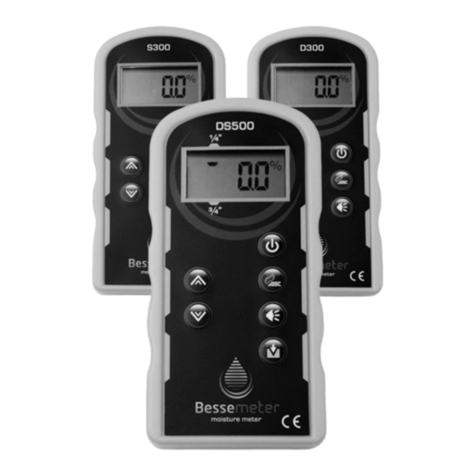
Bessemeter
Bessemeter S300 manual

Horiba Scientific
Horiba Scientific LAQUA F-74BW Quick manual
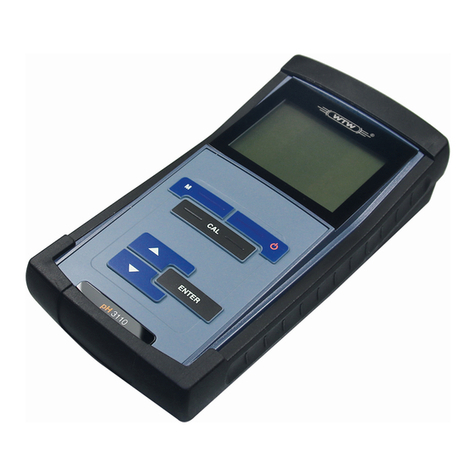
Xylem
Xylem WTW pH 3110 quick start guide
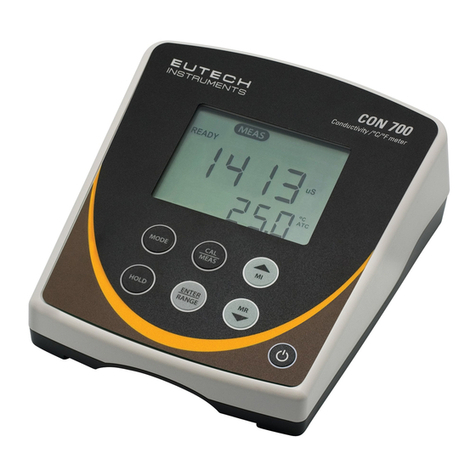
EUTECH INSTRUMENTS
EUTECH INSTRUMENTS CON 700 - REV 2 instruction manual
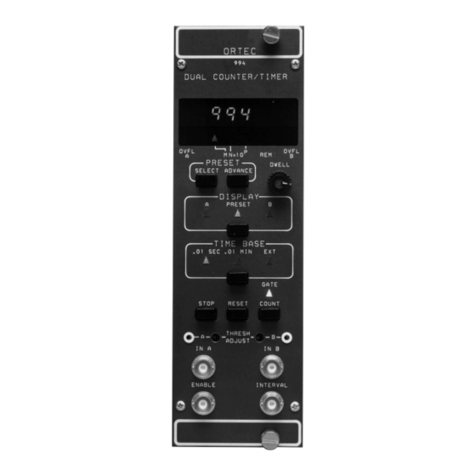
Ametek
Ametek Ortec 994 quick start guide

Veeder-Root
Veeder-Root DIS-51 Installation, Setup & Operation Guide
